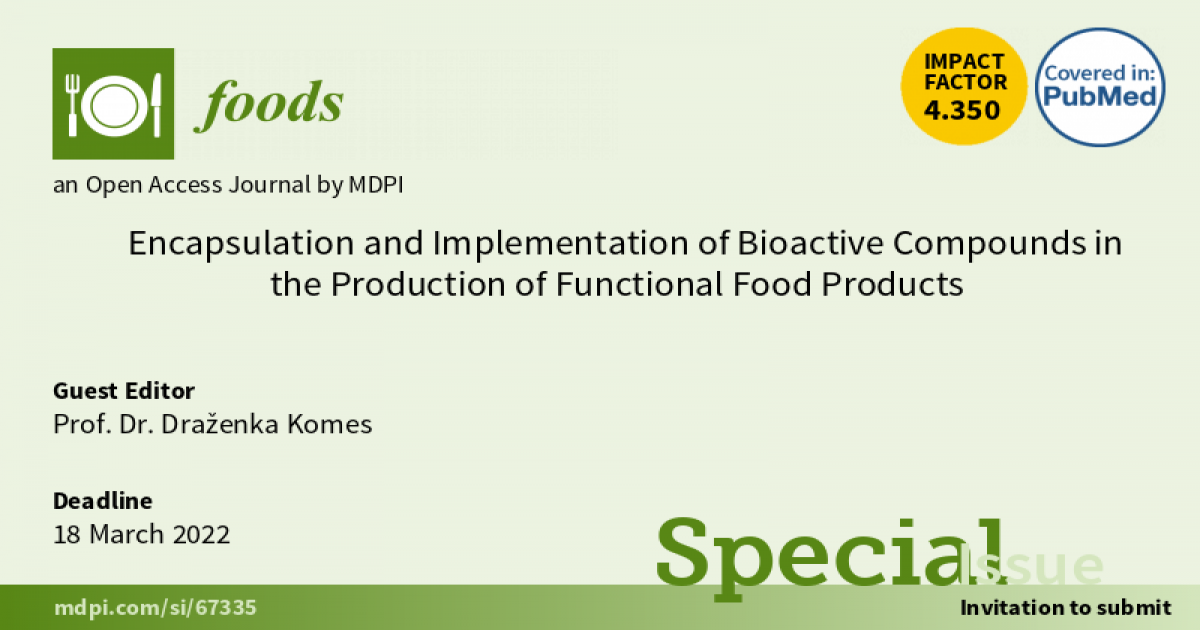Encapsulation and Implementation of Bioactive Compounds in the Production of Functional Food Products
A special issue of Foods (ISSN 2304-8158). This special issue belongs to the section "Food Engineering and Technology".
Deadline for manuscript submissions: closed (18 March 2022) | Viewed by 15936

Special Issue Editor
Interests: bioacive compounds; carbohydrate analysis; dietary fibre; encapsulation; functional food development; hydrocolloids; prebiotics; chemistry and technology of confectionery products, coffee and tea; valorisation of agro-industrial waste
Special Issues, Collections and Topics in MDPI journals
Special Issue Information
Dear Colleagues,
It is a great pleasure to introduce the Special Issue of Foods, entitled “Encapsulation and implementation of bioactive compounds in the production of functional food products.”
In accordance with the needs of modern society, partly resulting from the current COVID-19 pandemic, functional food consumption has become an integral part of everyday illness-preventive lifestyle. The incorporation of specific bioactive compounds into food products is a particularly challenging and interesting part of research and development of new functional products. In an effort to overcome the difficulties associated with the susceptibility of those compounds to degradation during processing or storage, as well as to increase their bioavailability and target-related function, the encapsulation of bioactive ingredients has proven to be a promising approach.
This Special Issue aims to highlight current progress in the development of new encapsulation-based delivery systems with a particular attention to the implementation of new technologies and new materials, as well as to the encapsulation of functional ingredients originating from agro-industrial wastes as a part of sustainable food production. The challenge consists in adopting the micro/nano-capsules containing active ingredients with a maximum of functionality to the whole food matrix. Therefore, innovative applications and an overall multidisciplinary approach to the topic are warmly welcomed.
The Special Issue is now open for submissions and you are cordially invited to submit review articles and original research papers.
Prof. Dr. Draženka Komes
Guest Editor
Manuscript Submission Information
Manuscripts should be submitted online at www.mdpi.com by registering and logging in to this website. Once you are registered, click here to go to the submission form. Manuscripts can be submitted until the deadline. All submissions that pass pre-check are peer-reviewed. Accepted papers will be published continuously in the journal (as soon as accepted) and will be listed together on the special issue website. Research articles, review articles as well as short communications are invited. For planned papers, a title and short abstract (about 100 words) can be sent to the Editorial Office for announcement on this website.
Submitted manuscripts should not have been published previously, nor be under consideration for publication elsewhere (except conference proceedings papers). All manuscripts are thoroughly refereed through a single-blind peer-review process. A guide for authors and other relevant information for submission of manuscripts is available on the Instructions for Authors page. Foods is an international peer-reviewed open access semimonthly journal published by MDPI.
Please visit the Instructions for Authors page before submitting a manuscript. The Article Processing Charge (APC) for publication in this open access journal is 2900 CHF (Swiss Francs). Submitted papers should be well formatted and use good English. Authors may use MDPI's English editing service prior to publication or during author revisions.
Keywords
- agro-industrial waste
- bioactive compounds
- bioavailability
- biological activities
- food-grade encapsulation materials
- functional food
- improved delivery systems
- innovative food design
- micro and nano-encapsulate properties
- natural antioxidants






